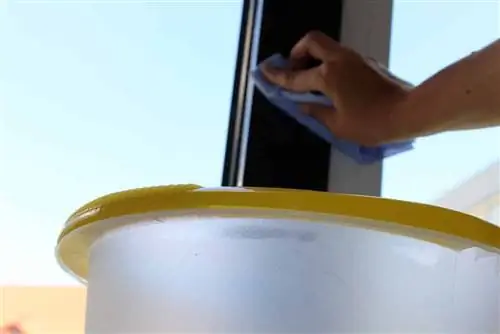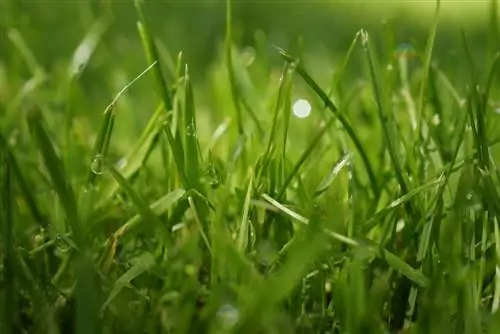- Author admin [email protected].
- Public 2023-12-17 03:39.
- Last modified 2025-06-01 06:48.
Grease stains, limescale residues and smudges - what can be quickly and easily removed from clear glass with an appropriate cleaning agent can become a problem on frosted glass. Chemical-based glass cleaners do not tolerate this. The chamois leather can also cause visible damage to the matt glass in the long term. Cleaning the frosted glass does not have to be expensive or time-consuming if the following tips are taken into account. Because with these, easy removal is possible even with heavy dirt.
Types of glass
In contrast to clear glass, cloudy or frosted glass is usually roughened on at least one side to create the satin effect. It is precisely this roughened side that reacts sensitively to the wrong materials and materials. Aggressive or abrasive products can damage the treated glass side and create permanent stains that cannot be removed. The satin finish was destroyed in these places. It is therefore important to clean properly right from the start.
Tip:
If it is frosted glass that is smooth on both sides and gets its cloudy effect from an admixture and not from roughening, nothing needs to be taken into account when cleaning.
Materials
Abrasive, rough materials should not be used to clean the frosted glass. The chamois leather must also not be used. Instead, soft, lint-free cloths should be used. Tea and microfiber cloths are ideal. Newspaper, which some people swear by when cleaning clear glass, should also be used with caution. Although it eliminates the need for cleaning agents, undesirable staining can occur. The result would be frosted glass with gray streaks caused by the printer's ink.
Medium
Aggressive chemical cleaning agents, non-biological or degradable glass cleaners should under no circumstances be used on frosted glass. They damage the satin finish, often permanently, and thus create unsightly spots and streaks. However, it is usually unnecessary to invest in expensive special cleaners.
Instead, lukewarm water is usually sufficient to clean the frosted glass. Light dirt can be easily removed by wiping it with a damp microfiber cloth. For more stubborn stains, however, the following products can be used:
- soft soap
- dishwashing liquid
- Vinegar or vinegar essence
- common s alt
- Potash
- Cleaning alcohol
Removing grease stains
The natural skin oils are enough to leave stains on frosted glass. Creams, fat splashes or fat films caused by cooking and frying can also have an unfavorable effect on the appearance. To remove this type of dirt, a mixture of soft soap and lukewarm water should be used on frosted glass. The soft soap is gentle on the glass but still effective and therefore ideal. As an alternative to soft soap, grease-dissolving detergent can also be used. After the grease stains have been removed with soapy water and a microfiber cloth, they should be wiped again with clear water. Finally, the frosted glass is rubbed dry with a lint-free cloth. This avoids grease and limescale residue.
Remove and avoid limescale residues
Stubborn limescale stains can appear on the cloudy glass, especially in the shower. But these can even occur when wiping with hard water, i.e. when cleaning. Vinegar water is best suited for removal. White vinegar or diluted vinegar essence are ideal. When cleaning the frosted glass, a microfiber cloth is covered with vinegar that has been heavily diluted with water and the limescale crusts are rubbed off with pressure. If this approach is not sufficient, the dosage of vinegar can be increased. Alternatively, you can add a little s alt or potash to your self-mixed cleaning solution.
In order to avoid limescale residues in advance, it should be rubbed dry immediately after contact with water and even if moisture condenses on the glass. A dash of vinegar in the cleaning water also prevents the stains.
Stubborn dirt

If dirt cannot be removed using the methods described so far, either table s alt or potash should be added to the respective products. However, not to such an extent that the s alt no longer dissolves in the mixture. The s alt must also not be used as a scouring agent. It is also recommended to initially use a sparing dosage of the respective cleaning agents and only increase this if necessary. In this way, glass, the environment and your wallet are protected. Special microfiber cloths for removing limescale or grease can also deal with stubborn dirt, so the investment is worth it - especially with frosted glass. Warm water should also be used as it dissolves stains better. Of course, it still makes sense to first “soak” the window with the cleaning solution and only clean it after a few minutes with appropriate pressure and circular movements.
Tip:
As a last resort, you should consider cleaning alcohol, which has a high dirt-dissolving power, but can also attack the glass.
Prevent smearers
Smears are not only unsightly on clear glass, but also appear on frosted glass and disrupt the appearance. To prevent this when cleaning, we recommend the procedure described as follows:
- Wipe the window pane with warm water or, if necessary, lather or soak with the above-mentioned cleaning products.
- Clean with an appropriate microfiber cloth in circular movements and with appropriate pressure.
- After using cleaning products, rinse or wipe with clean water.
- Immediately rub the damp milk glass dry with a lint-free cloth or tea towel.
In order to further reduce the risk for greasers, cleaning agents should be diluted as much as possible.
Frequency
Due to the special nature of the frosted glass, it is sensitive but attracts dirt and stains. Since stubborn dirt can be difficult to remove in some cases, you should use a damp microfiber cloth more often. Even greasy films, such as those created in the kitchen by cooking and frying, can be easily removed from the water without any additives if they are wiped off the frosted glass at least once a week. If you often use warm water and microfiber cloths, you can usually save yourself time-consuming and strenuous cleaning and cleaning products.
Discoloration and clear spots
If the frosted glass appears a little darker and less cloudy after cleaning, this is completely normal. After it has completely dried, the satin side will return to its usual appearance. The situation is different with clear spots and areas. This could be grease residue, for example caused by fingerprints. The surface treatment could also be damaged. If the matt, satin appearance does not return even after cleaning with soapy water or combining it with s alt, the latter is likely. Under no circumstances should you use an abrasive cloth or aggressive cleaning agent in order to remove the supposed stain. Such an approach would only worsen the problem and increase the damage.
Conclusion
If you frequently wipe the frosted glass with water and a microfiber cloth, you can usually avoid using cleaning products altogether. However, simple remedies such as vinegar and soft soap help against grease and limescale to thoroughly clean the frosted glass.






